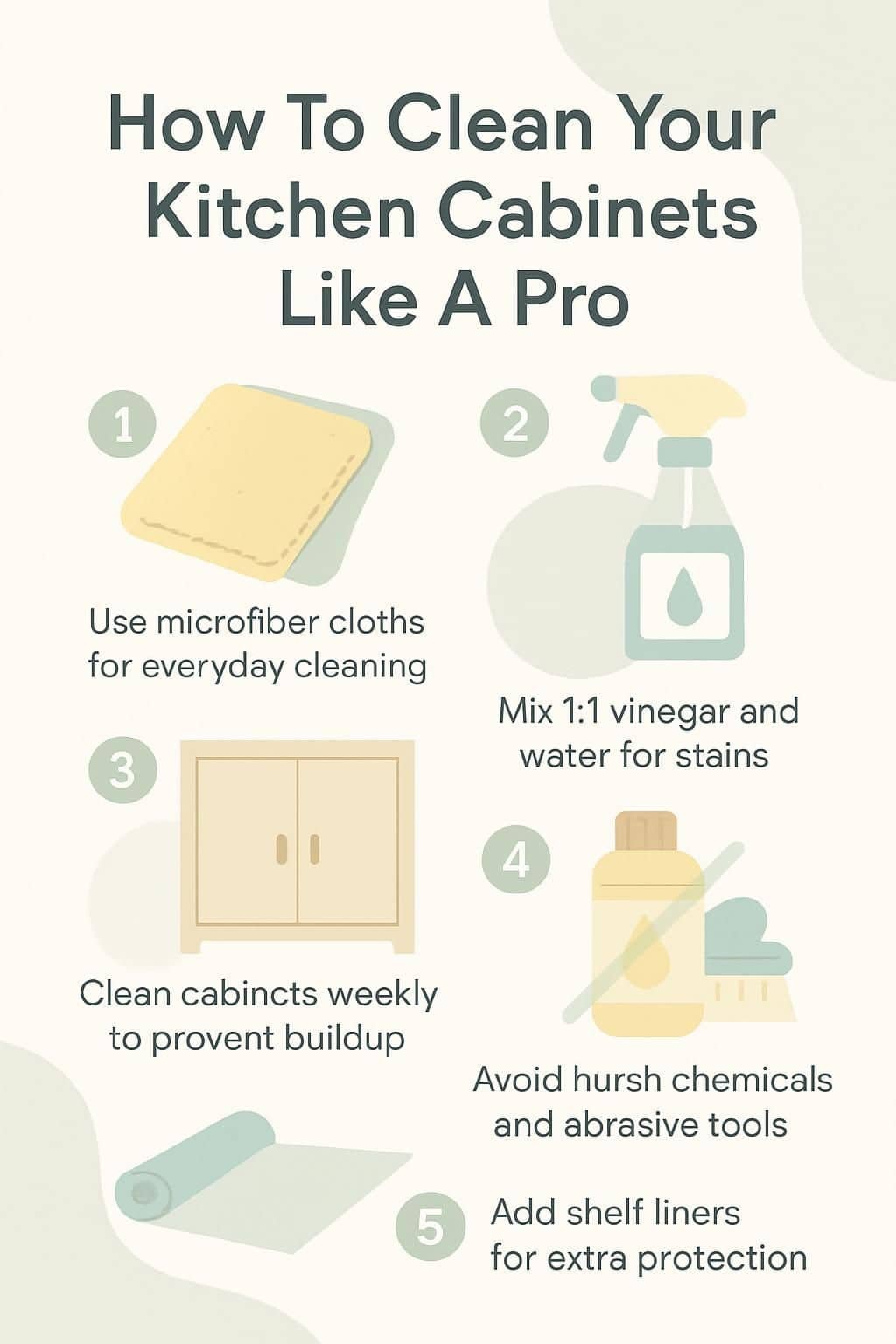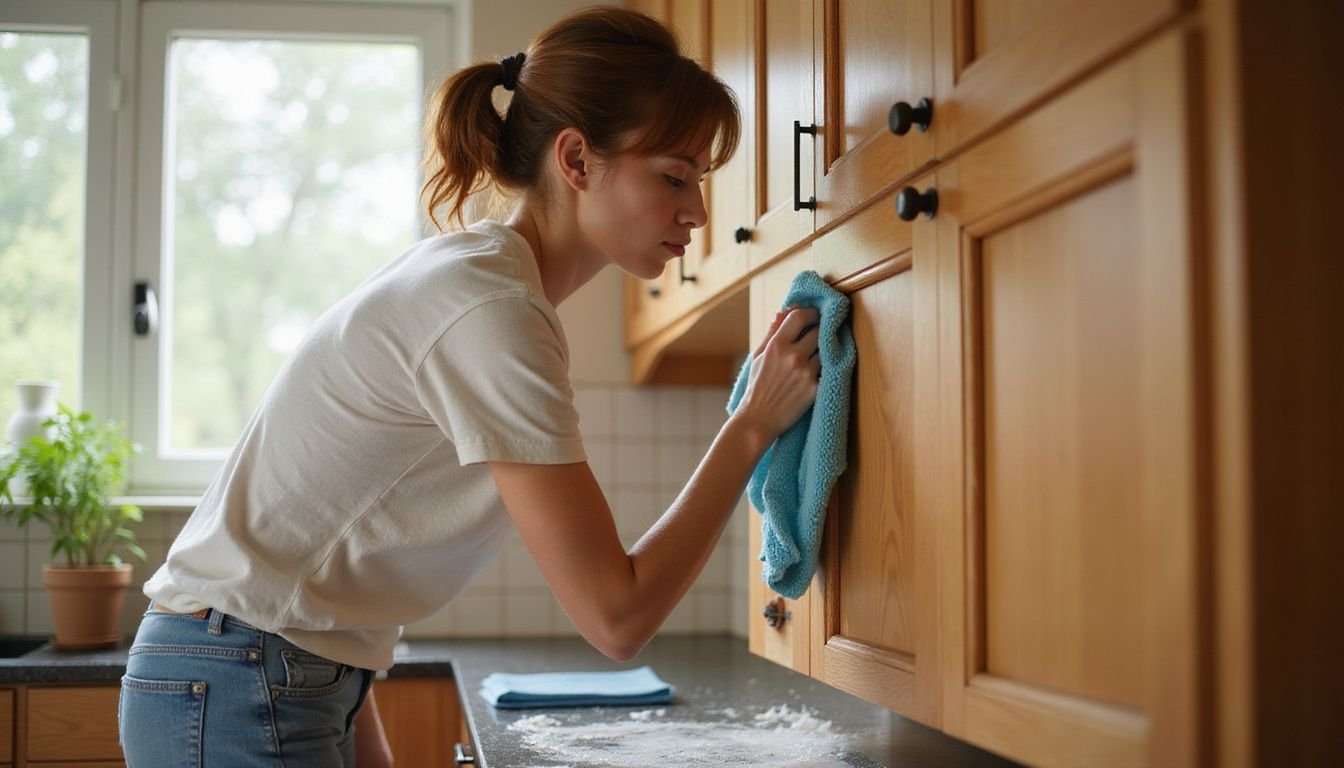Stained and sticky cabinets can make any kitchen feel messy. Many homeowners struggle to remove grease or stains, even after wiping again and again. How To Clean Your Kitchen Cabinets sometimes seems like a big job, but with the right steps, anyone can get great results.
Most kitchen cabinets collect dust and splatters every week. In fact, studies show that regular cabinet cleaning helps prevent damage from dirt or moisture. These habits keep your space looking fresh for longer.
This guide will walk readers through simple supplies, step-by-step routines, and expert tips for tackling cabinet messes. Readers will learn which ecofriendly cleaners are best for their home and how to use safe scrubbing techniques on different surfaces.
Discover easy ways to master kitchen maintenance in just a few minutes each week!

Essential Supplies for Cleaning Kitchen Cabinets

To clean kitchen cabinets effectively, gather essential supplies beforehand. Microfiber cloths and a mixture of dish soap with warm water work wonders for regular cleaning tasks.
Microfiber cloths
Microfiber cloths pick up dust, crumbs, and grease without scratching kitchen cabinet surfaces. Their fine fibers trap dirt better than old rags or paper towels. Many professional cleaning services use microfiber for surface cleaning because it leaves fewer streaks and reduces the risk of damage to wood or laminate cabinets.
A quality microfiber cloth can last through dozens of washes, making it an ecofriendly cleaner and cost-effective choice.
Using a dry or slightly damp microfiber cloth works well for everyday dusting cabinets and removing light fingerprints. For tougher spots like greasy handprints near handles, pairing the cloth with a bit of dish soap helps loosen grime gently.
Dish soap and warm water will make quick work of sticky buildup on your cabinet surfaces. Up next is a closer look at dish soap solutions for effective kitchen cabinet cleaning results.
Dish soap and warm water
A mix of dish soap and warm water handles surface cleaning for kitchen cabinets well. Dish soap cuts through grease and grime without damaging wood or laminate finishes. Most experts recommend adding just a few drops of mild, ecofriendly cleaner to a bucket of warm water.
Use a soft cloth soaked in the solution to wipe cabinet surfaces in gentle circles. Rinse the cloth often to avoid spreading dirt.
This technique offers an affordable and nontoxic way for homeowners and parents to maintain cabinet hygiene. Mild dish soap keeps bacteria at bay while protecting delicate surfaces from harsh chemicals found in some commercial cleaning solutions.
For daily messes or light grease removal, this method keeps things simple yet effective.
A little soapy water can go a long way on stubborn kitchen stains.
For tough marks or sticky spots that resist regular cleaning, try using vinegar or baking soda next.
Vinegar or baking soda for tough stains
Vinegar and baking soda both work well for removing stubborn stains from kitchen cabinets. Vinegar acts as an ecofriendly cleaner that cuts through grease and grime, making it perfect for surface cleaning on both wood and laminate cabinets.
Mix equal parts white vinegar and warm water in a spray bottle. Spray the solution on stained areas, then wipe with a microfiber cloth using gentle scrubbing techniques.
For sticky or caked-on spots, apply a paste of baking soda and water directly to the stain. Let it sit for 10 minutes before wiping clean with a damp cloth. Baking soda provides excellent grease removal without scratching cabinet surfaces or harming wood care finishes.
Follow up these methods before starting regular dusting routines for best results.
Regular Cleaning Routine
Cleaning kitchen cabinets regularly keeps them looking fresh. Dust and grease can build up, making surfaces appear dull. Wiping down cabinets with a microfiber cloth removes grime effectively.
This simple routine ensures that cabinet doors shine every day.
Dusting and wiping down cabinet surfaces
Dust cabinet surfaces regularly to keep them looking fresh. Use a microfiber cloth for effective dusting. This tool traps dust and prevents it from flying around. After dusting, dampen the cloth with warm water and a few drops of dish soap.
Wipe down each surface thoroughly.
Focus on areas where grease or fingerprints might build up. Pay special attention to knobs, handles, and edges. For tougher stains, try using vinegar or baking soda; these eco-friendly cleaners work wonders on stubborn spots without harsh chemicals.
Regular cleaning will keep kitchen cabinets in top shape while maintaining a pleasant environment for cooking and family gatherings.
Removing grease and fingerprints
Grease and fingerprints can make kitchen cabinets look dirty. First, grab a microfiber cloth. This type of cloth lifts dirt without scratching surfaces. Mix dish soap with warm water in a bowl.
Dampen the cloth with this soapy solution.
Wipe down the cabinet doors using gentle pressure. Focus on greasy spots and areas where fingerprints linger. For tougher stains, mix vinegar or baking soda into your cleaning routine.
These natural cleaners are effective for breaking down stubborn grease while keeping surfaces safe from damage. After cleaning, use a dry microfiber cloth to buff the cabinets for a shiny finish.
Deep Cleaning Method
To deep clean kitchen cabinets, first empty them completely. After removing all items, tackle debris and dust with a soft cloth before applying your chosen cleaning solution for scrubbing.
Emptying cabinets and removing debris
House owners should start by emptying their kitchen cabinets. This means taking out all dishes, pots, and pans. Next, they need to check for any expired items or clutter. Clearing out unnecessary debris helps create a fresh space for cleaning.
After removing the contents, wiping down the shelves becomes essential. Dust and crumbs often hide in corners. A microfiber cloth works well for this task. By completing these steps, individuals set the stage for a thorough deep clean of their cabinet surfaces.
Scrubbing with a safe cleaning solution
After emptying the cabinets and removing debris, choose a safe cleaning solution for scrubbing. A mixture of dish soap and warm water works well for most surfaces. For tough stains, vinegar or baking soda can be effective options.
Use a microfiber cloth to scrub down the cabinet surfaces gently. This method ensures no scratches occur while effectively lifting dirt and grease. Make sure to rinse the cloth frequently to avoid spreading grime around.
Keep moving in small sections to cover every area thoroughly.
Tips for Maintaining Cabinets
To maintain cabinets, homeowners should regularly check for signs of wear and tear. Utilizing shelf liners can help keep surfaces clean while providing protection against spills and scratches.
Use shelf liners to protect interiors
Shelf liners keep kitchen cabinet interiors safe from damage. These liners shield surfaces from scratches, grease, and spills. They make cleaning easier since you can simply wipe down the liner instead of scrubbing the entire shelf.
Choose a liner that suits your cabinets. Options include adhesive or non-adhesive types in various colors and patterns. This small addition enhances both protection and aesthetics, making cabinets look neat and organized while ensuring longevity.
House owners will appreciate how easy it is to maintain clean surfaces with these practical solutions in place.
Avoid harsh chemicals or abrasive tools
Use eco-friendly cleaners to protect kitchen cabinets. Harsh chemicals can damage wood finishes and laminates over time. Opt for gentle solutions like vinegar or baking soda instead.
These options effectively tackle grease removal while being safer for your family and the environment.
Avoid abrasive tools that scratch surfaces. Microfiber cloths work best because they are soft yet effective at lifting dirt and grime. Using non-toxic cleaners along with these cloths ensures a clean finish without harming cabinet materials.
Conclusion
Cleaning kitchen cabinets can transform any space. With the right supplies, anyone can tackle dirt and grime effectively. Regular maintenance keeps cabinets looking fresh and new. Embrace these techniques for a cleaner, more organized kitchen.
A little effort goes a long way in achieving that professional look.
FAQs
1. What are the best products to clean kitchen cabinets?
To clean kitchen cabinets like a pro, use gentle cleaners such as warm soapy water or vinegar mixed with water. Avoid harsh chemicals that can damage finishes.
2. How often should I clean my kitchen cabinets?
You should clean your kitchen cabinets at least once a month. Regular cleaning prevents buildup and keeps them looking fresh and new.
3. Should I remove items from my cabinets before cleaning?
Yes, removing items helps you reach all surfaces easily. It also allows for a thorough inspection of any spills or stains inside the cabinet.
4. How do I tackle tough stains on my cabinet doors?
For tough stains, create a paste using baking soda and water. Apply it to the stain, let it sit for a few minutes, then gently scrub with a soft cloth until it lifts away.


